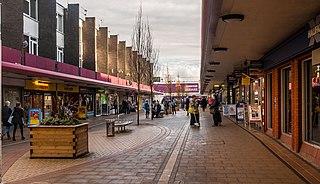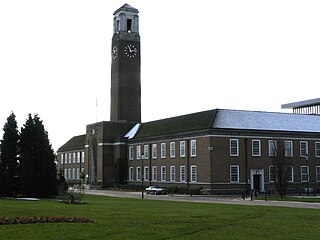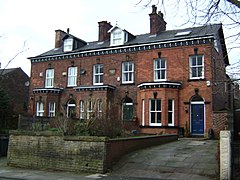
The Manchester Bolton & Bury Canal is a disused canal in Greater Manchester, England, built to link Bolton and Bury with Manchester. The canal, when fully opened, was 15 miles 1 furlong (24 km) long. It was accessed via a junction with the River Irwell in Salford. Seventeen locks were required to climb to the summit as it passed through Pendleton, heading northwest to Prestolee before it split northwest to Bolton and northeast to Bury. Between Bolton and Bury the canal was level and required no locks. Six aqueducts were built to allow the canal to cross the rivers Irwell and Tonge and several minor roads.

Worsley is a village in the City of Salford, Greater Manchester, England, which in 2014 had a population of 10,090. It lies along Worsley Brook, 6 miles (9.7 km) west of Manchester.

Pendlebury is a town in the City of Salford, Greater Manchester, England. The population at the 2011 Census was 13,069. It lies 4 miles (6 km) north-west of Manchester, 3 miles (5 km) north-west of Salford and 6 miles (10 km) south-east of Bolton.

Swinton is a town in the City of Salford in Greater Manchester, England. southwest of the River Irwell, 4 miles (6.4 km) northwest of Manchester, adjoining the town of Pendlebury and suburb of Clifton. In 2014, it had a population of 22,931.

Clifton railway station is a railway station in Clifton, Greater Manchester, England which was formerly called Clifton Junction. It lies on the Manchester–Preston line.

Kearsley is a town in the Metropolitan Borough of Bolton, Greater Manchester, England. The population at the 2011 census was 14,212. Within the Historic County of Lancashire, it lies 8 miles (13 km) northwest of Manchester, 5 miles (8 km) southwest of Bury and 3+3⁄4 miles (6 km) south of Bolton.

Swinton and Pendlebury was a local government district of the administrative county of Lancashire, England. It was created in 1894 as an urban district and enlarged in 1934, gaining the status of a municipal borough.
Agecroft is a suburban area of Pendlebury, within the City of Salford, Greater Manchester, England. It lies within the Irwell Valley, on the west bank of the River Irwell and along the course of the Manchester, Bolton & Bury Canal. It comprises a section of Pendlebury's high ground bisected by the A6044, its main thoroughfare; Kersal and Salford are across the river to the east. Agecroft Cemetery and HM Prison Forest Bank are in the area.
Irlams o' th' Height is a suburb of Salford, Greater Manchester, England, on top of the Irwell Valley, on higher ground than Pendleton, hence the name. The first part of the name derives from the Irlam family that ran the Pack Horse Inn in the 17th and 18th centuries.
Agecroft Colliery was a coal mine on the Manchester Coalfield that opened in 1844 in the Agecroft district of Pendlebury, Lancashire, England. It exploited the coal seams of the Middle Coal Measures of the Lancashire Coalfield. The colliery had two spells of use; the first between 1844 and 1932, when the most accessible coal seams were exploited, and a second lease of life after extensive development in the late 1950s to access the deepest seams.

Clifton Aqueduct, built in 1796, carried the Manchester, Bolton and Bury Canal across the River Irwell in Clifton, near Manchester, England. It is preserved as a Grade II listed structure. The aqueduct is constructed of dressed stone with brick arches. Three segmental arches with keystones rest on triangular-ended cutwaters. Above the cutwaters are flat Pilasters. A C20 brick parapet remains on the eastern side. There is a towpath on each side, and the aqueduct contains grooves for stop planks to be inserted, to drain the canal. The aqueduct was engineered by Charles Roberts and John Nightingale.

Wet Earth Colliery was a coal mine located on the Manchester Coalfield, in Clifton, Greater Manchester. The colliery site is now the location of Clifton Country Park. The colliery has a unique place in British coal mining history; apart from being one of the earliest pits in the country, it is the place where engineer James Brindley made water run uphill.

Wardley is a suburban area of the City of Salford, in Greater Manchester, England. It borders Linnyshaw, Walkden and Swinton.
Clifton Viaduct is a Grade II listed stone structure crossing the valley of the River Irwell in Clifton, Greater Manchester, and also the Manchester, Bolton and Bury Canal. It is known locally as the "13 Arches". It is currently disused and closed to the public.

Agecroft power station was a coal-fired power station between the eastern bank of the Manchester, Bolton and Bury Canal and the western bank of the River Irwell at Pendlebury, near Manchester, England. It operated between 1925 and 1993, and was demolished in 1994. HM Prison Forest Bank has since been built on the site.

The Irwell Valley in North West England extends from the Forest of Rossendale through the cities of Salford and Manchester. The River Irwell runs through the valley, along with the River Croal.
The Manchester, Bury and Rossendale Railway, opened in 1846, ran between Clifton, Bury and Rossendale in Lancashire, England. The company merged with the Blackburn, Burnley, Accrington & Colne Extension Railway (BBA&CER) to form the East Lancashire Railway.
Andrew Knowles and Sons was a coal mining company that operated on the Manchester Coalfield in and around Clifton near Pendlebury, in the historic county of Lancashire, England.
Matthew Fletcher was a mine owner and mining engineer in Lancashire, England.
Swinton and Pendlebury is a town in the City of Salford Metropolitan Borough, Greater Manchester, England. It contains 23 listed buildings that are recorded in the National Heritage List for England. Of these, one is listed at Grade I, the highest of the three grades, one is at Grade II*, the middle grade, and the others are at Grade II, the lowest grade. The listed buildings include houses, churches and items in churchyards, a public house, aqueducts, a railway viaduct, cemetery buildings, a bandstand and war memorials.














